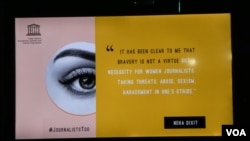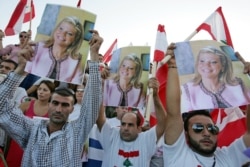The number of journalists killed in 2018 because of their work nearly doubled compared to 2017, according to the Committee to Protect Journalists. In all, 88 journalists and media workers died on the job, because they were targeted for their reporting or were working in hazardous environments.
Female journalists face the same dangers as their male counterparts when working on an assignment; but, women journalists face other threats that don't affect men to nearly the same degree.
At a recent Global Conference for Media Freedom in London, a panel discussed some of those threats and why it's important to find solutions.
Nadine Hoffman, deputy director of the International Women's Media Foundation, said that in a survey of 600 female journalists last year, more than two-thirds said they had experienced online harassment. She said those attacks are often sexual and misogynistic in nature.
"If you're a woman and you assert yourself in the online space, men will attack you," Hoffman said, noting that female politicians often experience the same kind of harassment.
'There must be laws'
May Chidiac, the Lebanese minister of state for administrative development, survived a 2005 car bombing while she worked as a television journalist. The assassination attempt was part of a series of bombings targeting journalists and politicians who were critical of Syria.
Chidiac said that online harassment is a serious threat to women. She said more must be done to protect journalists targeted by those attacks and to prosecute the perpetrators.
"Personally, I never considered myself different from a male journalist," she said. "But when it comes to online harassment, believe me, there is a big difference between men and women."
She said in addition to sending vulgar material and comments, critics sometimes publicly post personal details, like a woman's address or telephone number — an attack called "doxing" — putting her personal safety at risk.
"These are things that must not go unpunished," she said. "There must be laws to, in one way or another, protect women from such aggression and harassment."
Harassment by colleagues
Hoffman noted that one-third of the 2018 survey respondents said they considered leaving their newsroom because of such harassment. She added that another threat to women comes from within newsrooms: sexual harassment by colleagues.
Hoffman said that it's important to not dismiss such harassment as a workplace or human resources issue. Instead, she said it must be treated as a safety issue.
Hoffman said these threats are not taken as seriously as the dangers of reporting from hazardous locations or being targeted because of coverage of an organization or issue. But she warned that if these issues are not addressed, the impact goes beyond the individuals who leave the industry out of frustration or concern for their safety.
"Sexual harassment is a safety issue," she said. "Online harassment does have offline implications," she added. "Without women's voices, we cannot have truly democratic societies and a free press."









